
Sydney University Press Law Books

 |
[Home]
[Databases]
[WorldLII]
[Search]
[Feedback]
Sydney University Press Law Books |
 |
Most speakers at this summit have been looking at open access from the supply side, presenting the points of view of custodians of government information. What might we lob over the fence to whoever is on the other side? So far we have not paid much attention to this demand side - the potential beneficiaries of changed information policies. So I see it as my task to address what I believe is the core rationale for this policy initiative, which is the promotion of innovation and creativity. My perspective on the topic brings together my deep interest in the whole matter of innovation, and my long involvement with the digital content industries.
Why do we need to act on this possible policy initiative? I will try to put the question in the context of some conceptual frameworks and models of innovation, and of business models for information and content production. My premise is that data and information – content – is the currency of creativity and innovation. Information is what energises our national innovation system. Governments produce and hold a wealth of information and data.
Both creativity and innovation have become somewhat fuzzy terms. This leads me to begin with two texts for today, one secular and one sacred (in the interests of balance and even handedness). My first text comes from the venerable Henry Fowler’s Modern English Usage, where he writes:
creative is a term of praise much affected by the critics. It is presumably intended to mean something original, or something like that, but is preferred because it is more vague and less usual (cf. Seminal). It has been aptly called a ‘luscious, round, meaningless word’, and said to be ‘so much in honour that it is the clinching term of approval from the schoolroom to the advertiser’s studio’.
In other words, Fowler finds our use of the term ‘creative’ just a little bit vacuous. It’s probably fortunate he died before the word ‘innovative’ became the new ‘clinching term of approval’. Now many of those working on this open information initiative are lawyers, and what I like and respect about lawyers is their precision about words and terminology. The construction of language is at the core of their craft, and we can usefully apply this rigour to the reconstruction of meaning around innovation and creativity.
I take my second text from Genesis, and the account of the destruction of the tower of Babel. The Tower of Babel provides us with a splendid metaphor for the creation of a perfect market in information. For those who may have forgotten how the story goes, let me remind you of the text and try to draw out the lessons for today.
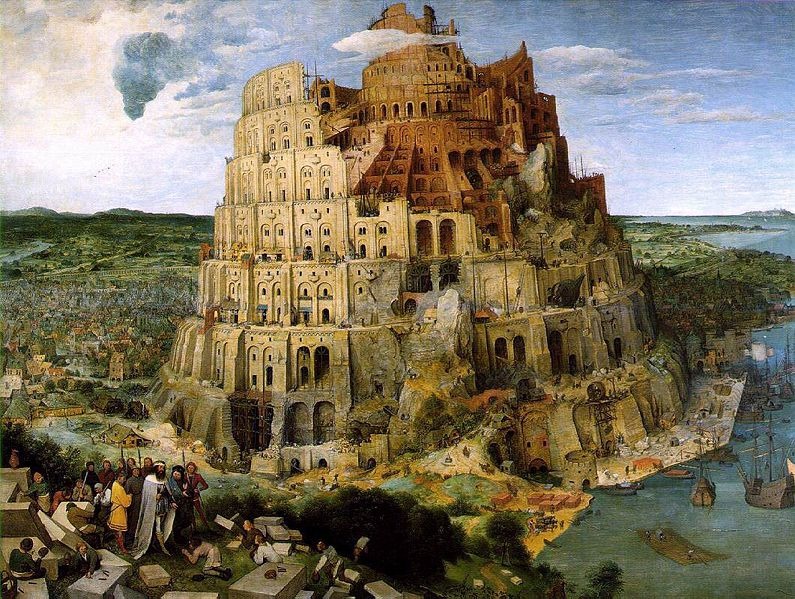
Source: Wikipedia, http://en.wikipedia.org/wiki/Image:Brueghel-tower-of-babel.jpg
Artist: Pieter Bruegel c. 1525/30
Genesis Chapter 11 begins with a vision of an information paradise (and a vision of ‘whole of government’ coherence) – ‘one language and one speech’.
1 And the whole earth was of one language, and of one speech.
2 And it came to pass, as they journeyed from the east, that they found a plain in the land of Shinar; and they dwelt there.
3 And they said one to another, Go to, let us make brick, and burn them thoroughly. And they had brick for stone, and slime had they for mortar.
4 And they said, Go to, let us build us a city and a tower, whose top may reach unto heaven; and let us make us a name, lest we be scattered abroad upon the face of the whole earth.
5 And the Lord came down to see the city and the tower, which the children builded.
6 And the Lord said, Behold, the people is one, and they have all one language; and this they begin to do: and now nothing will be restrained from them, which they have imagined to do.
7 Go to, let us go down, and there confound their language, that they may not understand one another's speech.
8 So the Lord scattered them abroad from thence upon the face of all the earth: and they left off to build the city.
9 Therefore is the name of it called Babel (confusion); because the Lord did there confound the language of all the earth: and from thence did the Lord scatter them abroad upon the face of all the earth.
- Genesis 11:1–9
Verse 6 reminds us of the power of a common infrastructure and shared knowledge. But suddenly, in the following verse, what I will render as Adam Smith’s curse descends on us. All that ‘which they have imagined to do’ is struck down through the specialisation of labour, the segmentation of academic disciplines and discourse, and the bureaucratisation of governance. Fragmentation and confusion ensues.
But, at the end, there is hope. An unintended consequence of the destruction of the Tower of Babel is the creation of diversity. And diversity is widely recognised as a pre-condition for creativity and innovation.
I will labour the point about the importance of precise language and clarity about concepts like innovation and creativity because, otherwise, these terms do not serve as reliable guides to action. We also need to remind ourselves regularly of just why being innovative is so important.
Innovation is critical to the competitiveness and sustainability of our economy and society. Yet, for all the fuzzy talk about it, and for all the platitudinous reports and business school prescripts, it is rarely the subject of rigorous examination and critical thinking. It is difficult to find a coherent, comprehensive account of innovation. You will find it difficult to unearth the term in standard economic textbooks. The reason for this is because neo-classical economics works predominately with closed models of the market: equilibrium models. Innovation, however, is all about change and economic development: disequilibrium and the breakthrough thinking from which we learn and build our stock of knowledge and, hopefully, of wisdom.
To set out an account of innovation I need to begin with a taxonomy of the terms involved, and the related concepts. With such building blocks we can begin to explore the dynamics of innovation as a change and learning process.

Source: Dr Terry Cutler, Submission to the Productivity Commission Inquiry into Public Support for Science and Innovation, July 2006, p7, available at www.pc.gov.au/__data/assets/pdf_file/0006/37662/sub043.pdf
Simply linking these terms and then sequencing them according to the underlying grammar – analogous to a DNA sequence – we can begin to derive a theory of innovation.
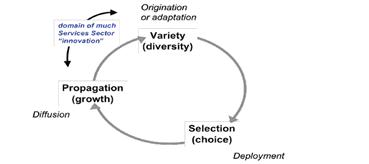
Source: Dr Terry Cutler, Submission to the Productivity Commission Inquiry into Public Support for Science and Innovation, July 2006, p11, available at www.pc.gov.au/__data/assets/pdf_file/0006/37662/sub043.pdf
This is an open model -as distinct from the closed models of neo-classical economics -which is comparable to and, indeed, refers to the open models we find in the life and physical sciences.[2]
The energy in this open system of innovation is creativity: the ideas and insights which produce the options for doing something differently. The accumulation of such thinking is a pool of options for future development. Without new ideas, this pool is not refreshed and becomes stagnant.[3] The value of ideas and inventions only comes into play when they are applied to problems or opportunities in markets or the community. The value is only fully realised when the innovation is taken up and used widely. In the process of adopting an innovation, moreover, adaptations and improvements will occur. This is because adoption will normally require adaptation to the context of the use. Thus the open-ended cycle of change and renewal will continue.
To elaborate this model into a more fully rounded theory of innovation we need resort to a mercator-like projection of the schematic.
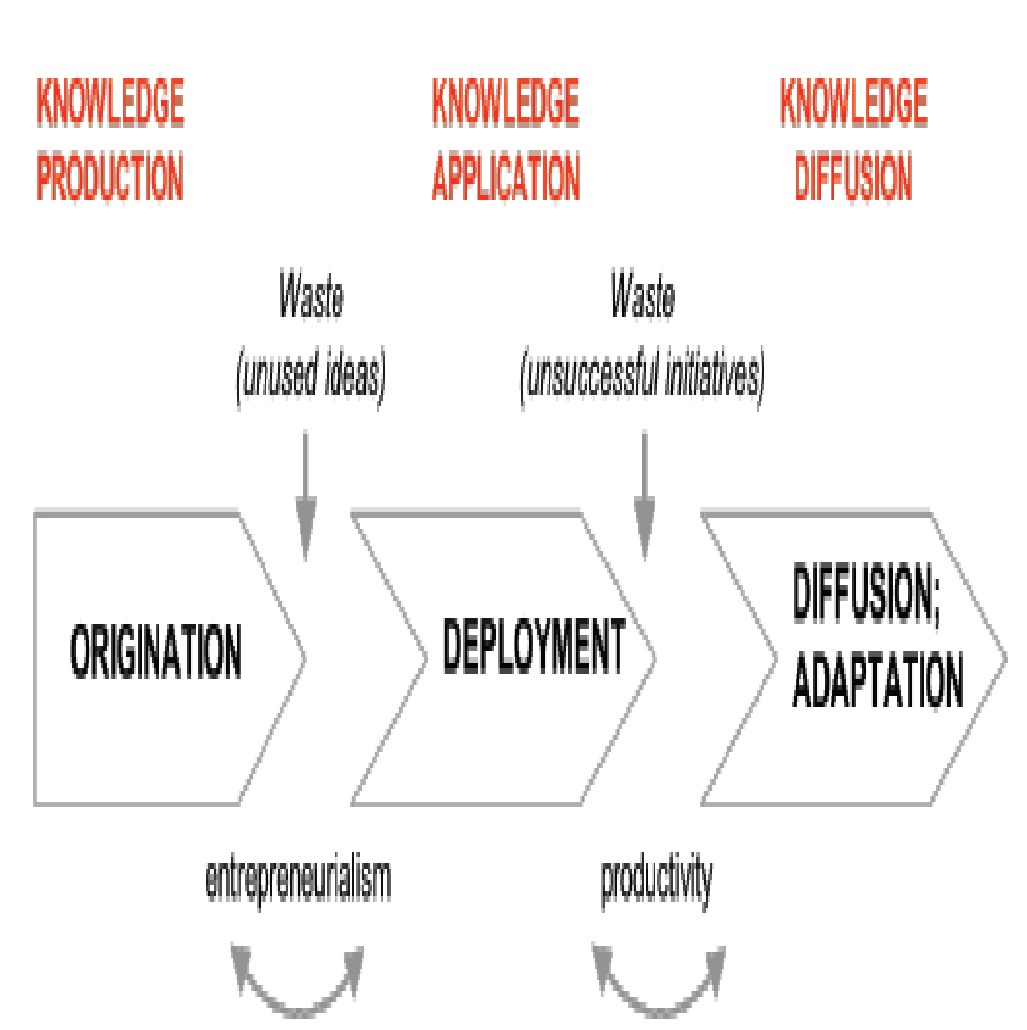
Source: Cutler 2006
There are five points I want to draw out from this schematic.
The first is that creativity and fresh thinking is invoked within each of the sub-systems or elements of the innovation process, and at the points of intersection between them.
Secondly, we need to look carefully at the entrepreneurial process of matching a capability with a need or opportunity. This is a purposeful process of selection, not a linear progression of ideas simply walking out of the laboratory or study into the marketplace. It is more productive to seek solutions to a need or opportunity than to hawk solutions in the search for a problem. This observation is, of course, at odds with contemporary cargo cults about the commercialisation of research.
Thirdly, productivity arises from the successful deployment of innovations, not from the innovation per se.
Fourth, information and data is the basic currency across this whole ecosystem.
Fifth, there is waste in the system, whether unused ideas – including possibilities stored away for revisiting later or ideas whose time has not yet come – or failed ventures, including situations where a venture may fail for reasons other than the merit of the innovation.
These last two points are highly relevant to considerations around access to public sector information. The originator, owner or custodian of information or data may not be best placed to understand the possible uses or potential future uses of the information or data they hold. Waste and the destruction of value may occur because government sets rules of access to information which fail to recognise the requirements of unforeseen users and uses. Furthermore, the rules of engagement between government and the initial agent – the immediate user or use– may unintentionally constrain the beneficial use by third parties or eventual end-users in the process of the diffusion of knowledge or innovation.[4]
While information is the currency of innovation, informational and content sources play different roles within different parts of the innovation system.
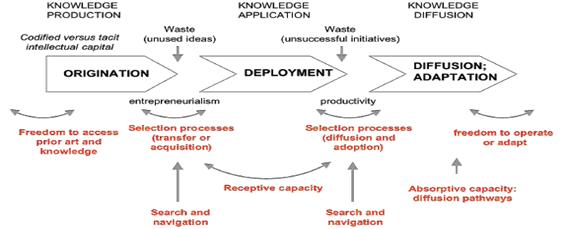
Source: Cutler 2006
Knowledge builds on knowledge. This has some important implications for innovation, and for considerations of access to public sector information.
First, even when an entrepreneur sees an opportunity, they need certain skills and domain knowledge to be able to understand the potential of new ideas and knowledge and to act on the opportunity. The existence of such skills will affect the capacity to form effective collaborations, whether as a firm or a project. The innovation process will falter in the absence of effective partners or collaborators. We talk about this as the receptive capacity of an industry or body politic. There may often be a public policy interest in improving this receptive capacity. Without it, innovation will be constrained.
Secondly, the wider diffusion and take-up of an innovation depends on the absorptive capacity of the community. For example, the take-up and sustainability of certain information technologies requires particular skill levels within the user population. Data sets are meaningless without the requisite analytical skills. Thus the education and skill levels of the general population become important considerations for everyone.
Thirdly, certain freedoms are essential to creativity and innovation.[5] The first is the freedom to access and use prior art and knowledge in the exploration and development of new knowledge and insights. It is obvious that open access underpins this freedom. Equally important, however, is the freedom to operate and adapt in the process of deployment and diffusion. The extent of this freedom will depend on what rules and conditions are imposed by the owners of an innovation. The terms of access to information and data will dictate the extent of further experimentation and development. This becomes particularly important when an innovation can usefully be packaged or integrated with other products or services. Systems integration is an increasingly significant platform for innovation, especially in the services sector.
My final point about innovation is that it is a complex system. Innovation functions at multiple, interdependent levels. At the heart of the matter is the individual person: call them artist, scientist, technician, knowledge worker or whatever. Individual people fuel the whole innovation system. We also talk a lot about collaborations between people, but for all the rhetoric we know that in practice it is hard.
The following matrix identifies five levels within an innovation system, each with discrete issues but all are highly interdependent. For each level there are discrete and distinctive institutional and human capital issues to be taken into account with each element of the innovation process (of origination, deployment, diffusion and adaptation).
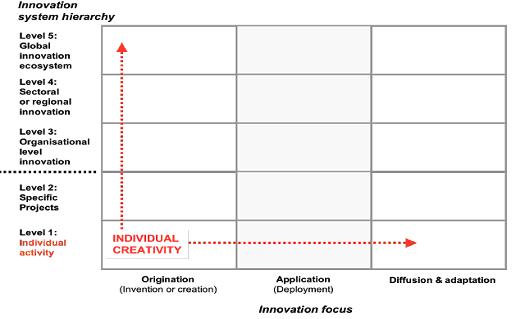
Source: Dr Terry Cutler, Submission to the Productivity Commission Inquiry into Public Support for Science and Innovation, July 2006, p18, available at www.pc.gov.au/__data/assets/pdf_file/0006/37662/sub043.pdf
Issues around access to information and content, and the role of public sector information, will vary across this matrix, both horizontally and vertically. It is arguable that simple and flexible digital content architectures will maximise the utility of public sector information and data sets across the variety of user environments implied by this matrix. The principle should be to empower the greatest possible range of uses, known and unforeseen.
I have argued that innovation is an open system. This resonates with industrial firms who increasingly are paying attention to the flow of knowledge and intellectual capital across organisational boundaries.
For most of the twentieth century firms pursued a model of in-house, proprietary research and development to sustain their innovation. With globalisation and the deconstruction of supply chains this model has become unsustainable. The dominant model of innovation has changed to an open model drawing on multiple internal and external sources of ideas and channels to market. This open innovation model emphasises knowledge flows rather than knowledge creation as a driver of innovation.
Diagram omitted from digital version
Please see hard copy for diagram. For hard copy, please contact Sydney University Press (www.sup.usyd.edu.au)
Source: From Open Innovation: The New Imperative for Creating And Profiting from Technology by Henry William Chesbrough, pp47. Copyright © 2003 by the Harvard Business School Publishing Corporation; All rights reserved. Reprinted by permission of Harvard Business School Press
Open innovation models recognise that one person’s trash is another person’s treasure. There is an inbuilt asymmetry between the owners or custodians of information, and potential users in terms of the uses of information and the value of those uses.
At a conference on e-Research which preceded this Summit, Dr Chris Greer from the National Science Foundation in the US spoke of cyberinfrastructure as a new fifth dimension and shared space. In thinking about such information and collaboration infrastructures, it struck me that many of the access issues we are debating around digital information have already been addressed in other domains, especially around open access to physical infrastructure. There are clearly lessons to be learned from the principles established for access to and the interconnection of deregulated telecommunications networks, and other forms of networked infrastructure.[6]
Access regulation for telecommunications networks is based on two major premises:
1. The utility and benefits of networks are promoted by ‘any to any’ connectivity (interoperability); and
2. Dominant players should not be able to create ‘bottlenecks’ to access.
A number of access principles[7] follow from these premises and include:
o Arrangements should promote efficiency;
o There should be reciprocity in rights and obligations;
o The economics of arrangements should be clear and unbundled, promoting:
• The desired level of investment in infrastructure (without wasteful duplication)
o Obstacles to users accessing services should be minimised; and
• The lowest possible transaction costs;
o Redundancy should be supported.
Network ‘interconnection and access’ principles are clearly applicable to information infrastructures and content networks. Content is the new access bottleneck. The access challenge escalates as functional interdependencies increase massively in a digital environment. As a principle, networked information flows should aim to support ‘any to any’ connectivity. This seems especially apposite in the case of public sector information.

Source: Joi Ito (2006).
Developing policies on access to information requires attention to the whole business system of content and information production. In a digital environment, the business system of content revolves around bit creation, bit storage, bit distribution, and bit use and re-use. A model I developed around this in 1994 still seems to stand up:
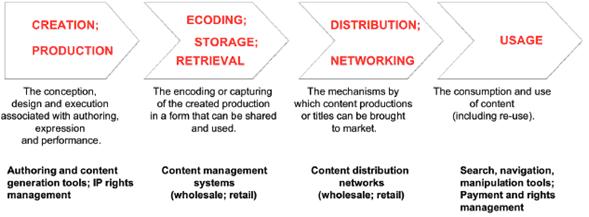
Source: Cutler & Company, Commerce in Content (1994), http://www.nla.gov.au/misc/cutler/cutlercp.html
In management jargon, digital content (information) production is more of a ‘value net’ than a serial value chain. This is because of the func-tional interdependencies within a digital ecosystem. The ‘freedom to operate’ and create within the producer or user environment – include the re-purposing of information – will be facilitated or constrained by the functionality of the supporting information infrastructure and its architecture. Policies for open access need to minimise the obstacles which may arise from these functional interdependencies.

Source: Cutler & Company, Commerce in Content (1994), http://www.nla.gov.au/misc/cutler/cutlercp.html
Why is open access to public sector information important for innovation? I have argued that it is important because knowledge and information flows underpin creativity and innovation. It is especially important in a small country economy like Australia because of the relative scope and scale of public sector information. The public sector is a major – even the dominant -producer and custodian of information. Furthermore, only government and the public sector have the critical mass to create inclusive public platforms and scalable repositories.
Ironically, open access policies could also help resolve the chronic problems with ‘silo’ barriers to information sharing within government – promoting greater ‘whole of Government’ effectiveness.
Information infrastructure and information architectures are crucial in an information society. Government information policies should promote:
o ‘freedoms to operate’ – ‘unfreedoms’ are the enemy of development and innovation; and
o open, end-to-end access as a fundamental premise of infrastructure.
The wise administration of public sector information can create significant economic benefits through strengthening the national innovation system. By its own practice, governments can help shape the rules and conduct of wider information markets. As with most things, however, the devil is in the detail. The utility of public information to users will be determined by the terms of access, including the efficacy of arrangements for such things as:
o information exclusions – open access should be the default setting;
o searchability and discovery;
o transparency of language and code;
o transaction costs; and
o the preservation of information and its long-run accumulation.
Good outcomes will require us to approach the principles of access from the perspective of prospective users, and with a keen regard to the potential obstacles and bottlenecks to the effective use of public sector information.
[1] Principal, Cutler & Co. This chapter is an extended version of speaking notes from the Australian National Summit on Open Access to Public Sector Information convened by the Law Faculty of Queensland University of Technology and supported by the Queensland Spatial Information Council. The Summit was held in Brisbane, Australia, on 13 July 2007, the day following the Legal Framework for e-Research Conference. I have taken the opportunity to elaborate upon my presentation in the interests of clarity. This paper draws on other work in progress, and my 2006 submission to the Productivity Commission’s Inquiry into Public Support for Research and Innovation.
[2] As an elaboration – beyond the confines of a short speech – this theoretical model resonates with Darwinian exposition and the language of thermodynamics and negative entropy. It is worth observing that Adam Smith himself would not be alarmed; Smith’s whole opus shows an acute awareness of historical progression and tipping points. His successor, Alfred Marshall, notably regretted never returning to the bigger picture of the dynamics of political economy after his excursion into the domain of abstracted and closed economic models. Schumpeter famously took up the challenge, but never quite got there.
[3] This insight is about how we actually can go backwards, as the history of many cultures demonstrates. This is the entropy of knowledge.
[4] Examples are pricing models or the processes of access, including technological requirements. Restrictions on ‘primary data’ or source code may inhibit useability and re-use.
[5] Both Karl Popper and Amartya Sen should be essential reading for any naysayer.
[6] I was personally involved in the early debates on these issues during the liberalisation of telecommunications markets in Australia and Asia in the early 1990s. Much of the clarity and sharpness of the principles then established has been eroded over time.
[7] Australian Telecommunication Authority (AUSTEL), Study of Arrangements and Charges for Interconnection and Equal Access, (1991).
AustLII:
Copyright Policy
|
Disclaimers
|
Privacy Policy
|
Feedback
URL: http://www.austlii.edu.au/au/journals/SydUPLawBk/2008/34.html